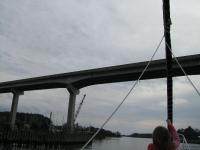 Have you ever been to an industrial site and seen the signs that say “103 days no accidents. Safety first.”? I feel like we should make a sign for the boat that says “10 miles no accidents”.
Have you ever been to an industrial site and seen the signs that say “103 days no accidents. Safety first.”? I feel like we should make a sign for the boat that says “10 miles no accidents”.
We transited from Jekyll Island to an anchorage just beyond Jekyll Island where we anchored for the night. It was really too dark to get anywhere further the first day off the dock. The next day, day before yesterday, we went a total of about 25 miles down to Fernandina Beach and grabbed a mooring. We were in by lunchtime. Yesterday we stayed put just because it was windy as heck and well, we wanted to. Today we started out to do a whopping 40 miles but got stopped at the first bridge.
We had noted that the guidebook we use stated that “unofficially” this set of bridges was considered among the “lowest” of the fixed 65′ bridges. Since it’s currently a full moon and a “spring tide” we are having high highs and low lows (for instance the regular low tide-called mean low tide- is nearly two feet higher than the current low tide). What this means is that if you normally have 65′ of clearance at a bridge when you have a “spring” high tide it’s only going to be around 63′ of clearance, since we require a minimum of 63’6″ this would be bad. Consequences to taking a boat with a 63’6″ mast under a 63′ bridge could include substantial damage to the mast and perhaps even dismasting not to mention damage to the bridge. Not good! So we timed our passage to go under the bridge during a lower portion of the tide. Unfortunately it was harder getting started than we anticipated due to the continued extreme wind so when we actually arrived at the bridge the tide was already higher than we’d aimed for.
We edged up to the bridge to consult the “tide board” a board, often (but not always) installed so that boaters coming up to the bridge can tell the actual height of the bridge above the water at that exact time. This set of bridges, of course, had no visible tide board so we edged a little closer. Through the bascule train bridge and into the miniscule void between it and the flue area that is the channel the boat must pass through to get under the bridge. Half way up the flue in the area just before you would actually pass under the bridge and plastered to the right hand side was the wayward tide board.
Of course this flue is only about 65 ft wide and the tide board is only visible (okay only readable) once you are beside it. So in we go, with a knot of current pushing us toward the bridge of unknown height at 6 knots and into the flue, which is acting like a sluice with the tide. Finally we can read the tide board and it says, you guessed it, 63 ½. Boyd made the decision on the spot that he didn’t want to risk it and decided to turn the boat around. In the 65 ft wide sluice, with a knot of current, and the wind behind us.
A few tense moments ensued while the entire crew of Passages took up posts at the bow and stern of the boat as Boyd turned in the center of the channel and without touching a single side board, either mast, or the bottom took us back out. It was truly an amazing feat to get a 47′ boat going 6 knots to turn 180 degrees in a 65 ft wide channel with a knot of current and substantial wind. If I had a video guys, I’d post it – you would be so impressed, I know I was!
Out we went back past the Bascule bridge and anchored for about 3 hours until the tide dropped to a lower level which made the height to the bottom of the bridge a more acceptable number. As we hurried toward the bridge eager to make up for lost time Paul (our current lookout) called back that there was a boat flashing a light at us from the other side of the bridge.
Wouldn’t you know it now that we’d waited the 3 hours for the tide the DOT was doing a repair to the light on the bridge and had a bucket truck perched up on top of the bridge with the bucket hung over the edge and suspended down into the air space we’d just waited not so patiently for.
Now you are beginning to get the picture. Today we made a total of about 8 nm. So in the last 3 days since left Jekyll Island I think we may have averaged 10 miles a day… BUT WITH NO ACCIDENTS.
